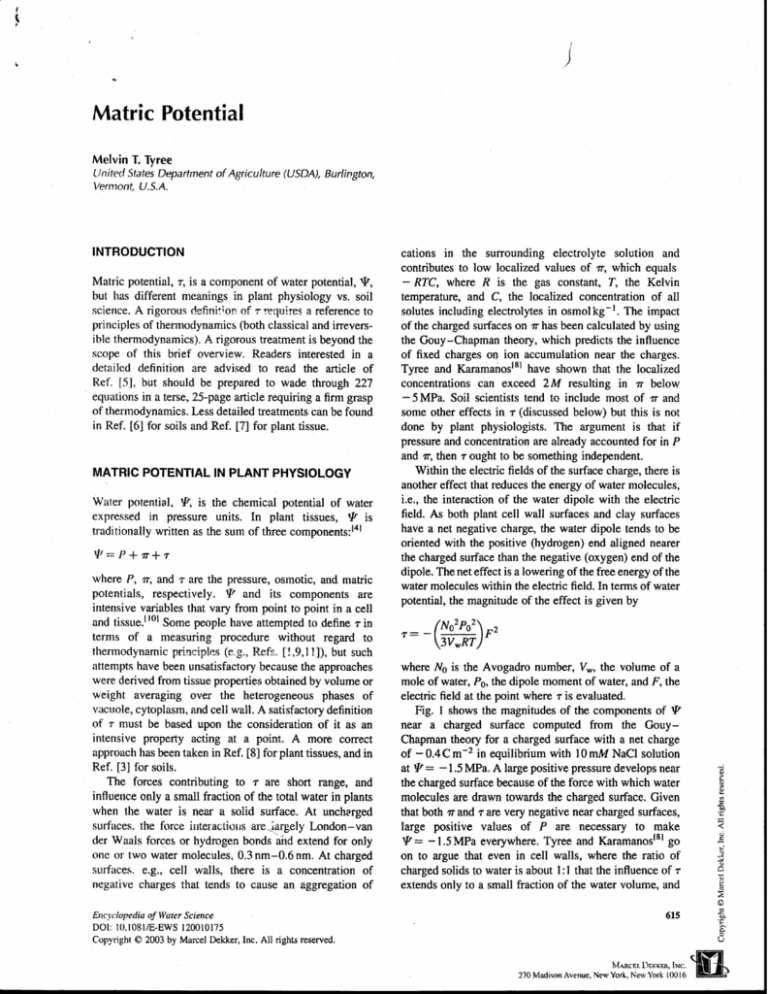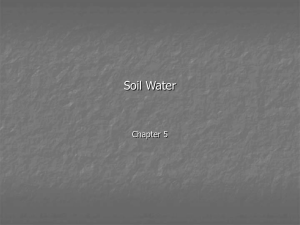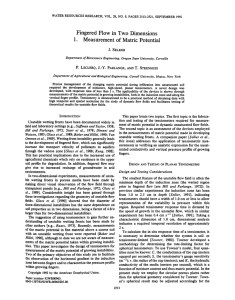
Matric Potential
Melvin T. Tyree
United States Departrnent of Agriculture (USDA), Burlir?gton,
\/er7?70r~t,U.S.A.
INTRODUCTION
Matric potential, r, is a component of water potential, !P,
b~lthas different meanings in plant physiology vs. soil
science. A rigorous definitioR of T requires a reference to
principles of thermotfynarr~ics(both classical and irreversible thermodynamics). A rigorous treatment is beyond the
scope of this brief overview. Readers interested in a
detailed definition are advised to read the article of
Ref. [ S ] , but should be prepared to wade through 227
eqt~atiotisin a terse, 25-page article requiring a firm grasp
of thennodynamics. Less detailed treatments can be found
in Ref. [ti] for soils and Ref. [7] for plant tissue.
MATRIC POTENTIAL IN PLANT PHYSIOLOGY
Water potential, P, is the chemical potential of water
expressecl in pressure units. In plant tissues, P
! is
traditionally written as the sum of three components:141
where P, 71; and T are the pressure, osmotic, and matric
potentials, respectively. ?P and its components are
intensive variables that vary from point to point in a cell
~ ~ people have attempted to define T in
and t i s s ~ e . "Some
terms of a measuring procedure without regard to
thermodynamic principles (e.g., Refs. [2,9,1I]), but such
attempts have been unsatisfactory because the approaches
we,re derived from tissue properties obtained by volume or
weight averaging over the heterogeneous phases of
\lac~.~ole,
cytoplasm, and cell wall. A satisfactorydefinition
of 7 must be based upon the consideration of it as an
intensive property acting at a point. A more correct
approach has been taken in Ref. [8] for plant tissues, and in
Ref. [3] for soils.
The forces contributing to T are short range, and
influence only a small fraction of the total water in plants
when the water is near a solid surface. At uncharged
surfaces. the force iiiteractioiis are..iargely London-van
der Waals forces or hydrogen bonds &d extend for only
one or two water n~olecules,0.3 nm-0.6 nm. At charged
surfaces. e.g., cell walls, there is a concentration of
negative charges that tends to cause an aggregation of
cations in the surrounding electrolyte solution and
contributes to low localized values of .rr, which equals
- RTC, where R is the gas constant, T, the Kelvin
temperature, and C, the localized concentration of all
solutes including electrolytes in osmol kg-*. The impact
of the charged surfaces on .sr has been calculated by using
the Gouy-Chapman theory, which predicts the influence
of fixed charges on ion accumulation near the charges.
have shown that the localized
Tyree and ~aramanos'~'
concentrations can exceed 2M resulting in T below
- 5 MPa. Soil scientists tend to include most of T and
some other effects in r (discussed below) but this is not
done by plant physiologists. The argument is that if
pressure and concentration are already accounted for in P
and n; then T ought to be something independent.
Within the electric fields of the surface charge, there is
another effect that reduces the energy of water molecules,
i.e., the interaction of the water dipole with the electric
field. As both plant cell wall surfaces and clay surfaces
have a net negative charge, the water dipole tends to be
oriented with the positive (hydrogen) end aligned nearer
the charged surface than the negative (oxygen) end of the
dipole. The net effect is a lowering of the free energy of the
water molecules within the electric field. In terms of water
potential, the magnitude of the effect is given by
where No is the Avogadro number, V,, the volume of a
mole of water, Po, the dipole moment of water, and F, the
electric field at the point where r is evaluated.
Fig. 1 shows the magnitudes of the components of ?P
near a charged surface computed from the GouyChapman theory for a charged surface with a net charge
of - 0.4 C m-* in equilibrium with 10 m M NaCl solution
at P = - 1.5 MPa. A large positive pressure develops near
the charged surface because of the force with which water
molecules are drawn towards the charged surface. Given
that both rr and T are very negative near charged surfaces,
large positive values of P are necessary to make
?P = - 1.5 MPa everywhere. Tyree and ~ a r a m a n o s 'go
~'
on to argue that even in cell walls, where the ratio of
charged solids to water is about 1:1 that the influence of r
extends only to a small fraction of the water volume, and
Ei:rlcyclul?ediuof Mruter Science
DOI: lO.IO8lIE-EWS120010175
Copyright Q 2003 by Marcel Dekker, Inc. All rights reserved.
MARCEI.L~EKKER, INC.
270 Madisori Avenue. New York, Eew York I 0 0 16
Matric Potential
Distance from charged surface, nm
Fig. 1 The cornpollents of water potential near a charged surface according to the Gouy-Chapman double layer theory with a surface
charge of - 0.4 C m-*.The univalent ion concentration outside the double layer is taken as 10mM. T and r are calculated at distances
I'rom the charged surface from the calculated electrical potential and electric field, respectively. P = !P+ T + r with ?P= - 1.5MPa.
(From Ref. [8].)
will begin to influence measures of P
! only when water
potentials approach - I4MPa, at which point most plants
are dead anyway. So, as defined by plant physiologists, T
can usually be ignored.
MATRIC POTENTIAL IN SOIL SCIENCE
Matric potential in soil science, T ~ was
, originally defined
in lerins of the instrument(s) used to measure r,. Note that
the subscript, s, is used in in soil science to distinguish it
from the Tin plant physiology. In situ measurement of T~in
soils is made with a tensiometer, which consists of a waterfilled tube with an attached pressure sensor. The fluid in
the tube makes contact with the soil water through a
polqousplate (often ceramic). When the soil is wet, the fluid
in the tensiometer is in good contact with the soil water
and is at a pressure of OMPa relative to atmospheric
pressure. As the soil dries, the fluid pressure drops below
atlnospheric. When the pressure drops below that of a
perfect vacuum ( - 0.1013 MPa), the water column usually
cavitates, i.e., an air bubble forms because of a breakdown
in the adhesion of water to the solid surfaces of the
tensiometer. Cavitations limit the range of useful
measurement of r, using tensiometers, as most plants
can function well to rs < - 1.5MPa. It is possible to make
fluid-filled pressure-measuring devices (called cell pressure probes) that can measure fluid pressures down to
- 1 MPa in plant cells, but these have never been used in
soils and probably would not work reliably.
In order to measure T, below - 0.1 MPa, the soil
samples have to be removed and placed in another
apparatus. One such system is a pressure plate apparatus.
The soil is placed at the bottom of a pressure chamber. The
bottom of the chamber is porous so that water can pass
through the porous plate when air pressure above the soil is
increased high enough to extract water from the soil. The
value of rs is equated to -(the applied pressure) at an
incipient water extraction. Water can also be extracted
from the soil in a centrifuge. The soil is spun in the
centrifuge tube with a porous bottom until the centrifugal
force (expressed in pressure units) is sufficient to extract
water and r, is equated to - (the centrifugal force).
A number of papers have been written to discuss what,
based on thermodynamic theory, is measured by the
instruments described earlier. ~ a s s i o u r a ' equates
~~
T,
approximately with ?P. To be precise, T, = ?Ir - m,
where T,-,is the osmotic potential of the "equilibrium
dialysate," i.e., the osmotic potential of the soil solutes that
can pass through the porous plate of the tensiometer or
pressure plate apparatus or centrifuge tube. The ions in
solution in the ion "cloud" near the charged surface of soil
particles would not be included in m, because these ions
are not extractable. In most soils, ? . r ~ is usually
! within
r - 0.02 MPa; hence in drying soils, r, P
good tolerance. In a more recent exhaustive treatment of
4RC'EI
I )\?likrfL, IN<
270 Madison .%\c'nue.Uew Yorh, Ne\vYork 100 16
Riatric Potential
the theory behind T,,it appears that 7,is identified exactly
with ?4fin the equilibrium vapor phase of soils, i.e., see Eq.
202 in Ref. [5]. Hence, this meaning of 7,is identical to the
n~eaningof F,which is cft::n c.lso measured on plant tissue
by using the equilibrium vapor phase.
CONCLUSIONS
Nlarric potential as used by soil scientists is nearly
identical with water potential as used by plant physiologists. The main difference is that plant physiologists
divide water potential into two quantities that frequently
can be measured independently, i.e., pressure potential, P,
and osmotic potential, T. Soil physicists like to equate
illat ric potential in plants wiih "capillary or adsorption
forces which in a plant are forces such as those at the cell
walls."'2' However, this definition is equivalent to water
potential, V, and does nothing to help elucidate the
O S I I I O ~ ~ relations
C
of living cells that can be quantified only
by independent measures of P and v. In the older plant
physiology literature, some people attempted to come up
with a different meaning of matric potential, but this
It is unfortunate that
approach has been di~credited.''~~]
these two closely allied sciences should use different
words to describe the same quantity (matric potential vs.
water potential), but the attentive reader can usually
distinguish the mear~ing of matric potential from the
context of scientific reports.
REFERENCES
Acock, B. An Equilibrium Model of Leaf Water Potentials
Which Separates Intra- and Extracellular Potentials. Aust.
J. Plant Physiol. 1975, 2, 253-263.
Baver, L.D.; Gardner, W.H.; Gardner, W.R. Soil Physics,
4th Ed.; Wiley: New York, 1972; 293-295.
Bolt, G.H.; Miller, R.D. Calculation of Total and
Component Potentials of Water in Soils. Trans. Am.
Geophys. Union 1958,39,917-928.
Dainty, J. Water Relations of Plant Cells. In Erzcyclopedia
of Plant Physiology N.S.; Liittge, U., Pitman, M.G., Eds.;
Springer-Verlag: Berlin, 1976; Vol. 2A, 12-35.
Nitao, J.J.; Bear, J. Potentialsand Their Role in Transport in
Porous Media. Water Resour. Res. 1996,32,225-250.
Passioura, J.B. The Meaning of Matric Potential. J. Exp.
Bot. 1980,31, 1 161 - 1 169.
Tyree, M.T.; Jarvis, P.G. Water in Tissues and Cells. In
Encyclopedia of Plant Physiology N.S.Physiological Plant
Ecology; Lange, O., Nobel, P.S., Osmond, C.B., Eds.;
Springer-Verlag: Berlin, 1982; Vol. 12B, 35-77.
Tyree, M.T.; Karamanos, A.J. Water Stress as an
Ecological Factor. In Plants nnd Their Atniospheric
Environment; Grace, J., Ford, E.D.,Jarvis, P.G., Eds.;
Blackwell: Oxford, 1980; 237-261.
Warren Wilson, J. The Components of Leaf Water
Potential. Aust. J. Biol. Sci. 1967, 20, 329-347.
Weatherley, P.E. Some Aspects of Water Relations. Adv.
Bot. Res. 1970,3, 171-206.
Wiebe, H.W. Matric Potential of Several Plant Tissues and
Biocolloids. Plant Physiol. 1966,41, 1439- 1442.
MAIU'EII~RKKEII,INC-.
270 kladisor~Avenue. New York, New York 10016









